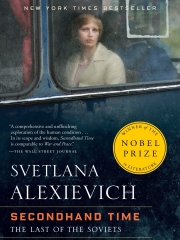Secondhand Time by Svetlana Alexievich
Back in school, I always thought history was a bug in amber. All these crazy leaders and wars were done away with, a thing of the past. Nowadays we just live normal, peaceful lives. Ignorance is bliss.
1) When Gorbachev came to power in the mid 1980s, he began liberating reforms known as perestroika and glasnost.
Gorbachev promoted openness of the markets and the government, bringing about the beginning of the end of USSR.
2) In 1991, the Gang of Eight (GKChP) staged a coup but failed as protestors and the army ultimately sided with Gorbachev and Yeltsin.
The putsch pitted communist supporters against the more liberal Gorbachev supporters. I had to fact check this a few times since the communists being the opposition went against my mental model of the Soviet Union.
3) Just two years later in 1993, Yeltsin faced off against the parliament, and this time the protestors were against Yeltsin.
The crisis led to the most deaths since the Russian Revolution and signaled growing discontent under the liberal reforms.
4) Sovok is a derogatory term used to describe supporters of the Soviet regime.
Gen Z makes fun of the boomers now, but I’m sure that very soon Gen Z will be ridiculed for its beliefs.
5) Single-family apartments built during the Khrushchev era were known as krushchevkas.
The kitchens in these apartments became part of Soviet culture. People would play loud music in the background to foil wiretapping.
6) The Soviet Union had stages of youth organizations: Little Octobrists, Young Pioneers, and Komsomol.
Many of the interviewees looked back fondly on their time as a Young Pioneer. Side note: “Little Octobrists” is a great name.
7) Armenia and Azerbaijan were engaged in the Nagorno-Karabakh ethnic conflict.
In a way, the Soviet Union had held everything together. We always talk about the Eastern bloc, but Central Asia is also full of former Soviet republics.
8) Russians have returned to the Orthodox Church after the fall of the Soviet Union.
Self reported numbers are tricky to interpret, but as one interviewee says in the book, people need therapists.
9) Blue jeans and salami became symbols of capitalism.
“We’d stand in line for five or six hours at a time… But you’re standing there with a book that you hadn’t been able to buy before.”
10) The Gulag Archipelago is the prominent example of samizdat.
3 volumes?
I love this style of primary source-based journalistic book. I learned a ton about the tragic decade of the 1990s for Russians. Beyond the historical facts, the personal stories were extremely engaging and sad. I have to admit that this book is likely very biased but at least it provides a deeply emotional point of view. The fall of the Soviet Union still resonates today. Having seen its demise, how can any country allow itself to fall apart? Stepping back even more, the capitalist values in vogue today are not a given. Why is it heroic to buy low and sell high?
